The white continent as a stepping stone to the red planet Understand article
For scientists at the European Space Agency, a mission to Mars means going to Antarctica first.
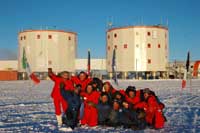
station
Copyright Programma
Nazionale di Ricerche in
Antartide – Istituto Polare Emile
Victor. All rights reserved
Three kilometres above sea level, 1000 km inland and -60 °C, Dome C, an ice plateau deep in the Antarctic interior, is one of the most remote and inhospitable places on Earth. Since 2005, it has also been home to the staff of the French-Italian Concordia research stationw1.
The tough environment is a constant challenge to the team that lives there year round. Concordia is busy for the short Antarctic summer, when up to 50 staff call the base home. But after the last plane of the season leaves in late February, Concordia is cut off from the world. For the next eight months, the skeleton crew of 12-14 scientists, engineers and support staff are on their own.

Image courtesy of NASA
This combination of isolation and extreme conditions makes Concordia an interesting place for the European Space Agency (ESA; see box): it’s about as close to a space mission as you can get without leaving Earth. So while Concordia’s scientists study astrophysics, glaciology, seismology and the hole in the ozone layer, an ESA-sponsored researcher lives among them, observing the station’s crew for clues about how a long space mission might affect the physical and mental health of astronauts.
“If you look at the expected characteristics of a future mission to Mars, for example,” says Oliver Angerer, ESA’s co-ordinator for research at Concordia station, “those scenarios typically also have a very small crew size, even smaller than the crew of Concordia: most scenarios have four to six crew members.
“And those people are also in a confined space, in a very harsh environment – of course, the vacuum of space; where the normal day and night cycles are absent, where you have very limited resources, where you have to deal with any emergency that comes up with the resources that you have at hand.”
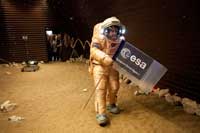
at the simulated Martian
terrain of the Mars500
experiment
Image courtesy of ESA
ESA’s interest in this kind of scenario also underpinned the recent Mars500 experimentw2, in which volunteers were sealed in a spaceship simulator for 520 days, the expected duration of a round trip to the red planet. In some ways, such as the very close confinement and the selection of the crew, the Mars500 simulation was more similar to a space mission than the Concordia scenario. The crew of Mars500, however, were exposed to no real dangers and were carrying out a scientific programme well beyond what would ever be reasonable in a space mission.
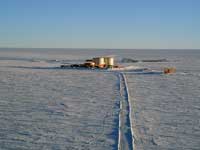
station
Image courtesy of Stephen
Hudson; image source:
Wikimedia Commons
In those respects, Concordia provides a more realistic analogue of space travel. “When researching space travel, we need both simulations and analogues; they are complementary, as their advantages and disadvantages essentially mirror each other,” explains Oliver.
The small group that lives at Concordia over the Antarctic winter is a little bigger than the crew of a space mission, but the pressure on their mental and physical health is similarly intense. For this reason, nobody lives on the base permanently – the staff members are exchanged every summer.
This goes for the ESA-sponsored researcher too – the latest arrival is Alexander Kumarw3, a British doctor who arrived at Concordia in January 2012.
This regular turnover has allowed for interesting comparisons between different crews. Research on the very first group to spend winter on the base, in 2005, revealed that they generally coped better than those that came after them, perhaps because they had to work together on the big task of finishing the construction and commissioning of the station. This kind of shared objective is an important way of keeping morale up.
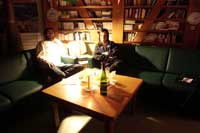
Copyright Programma
Nazionale di Ricerche in
Antartide – Istituto Polare Emile
Victor. All rights reserved
Sitting down together to share meals also helps, Oliver says, particularly in the three months in the middle of winter when the Sun does not rise above the horizon. “It’s something that gives a bit of a structure,” he says, “especially because there is no obvious day or night.” Shared meals aren’t always possible, though – life at Concordia is busy. A lot of the research there is astronomy, and the astronomers are often on a different schedule to the rest of the crew.
Under normal conditions, a surprising amount of our physiology and behaviour follows a circadian (daily) rhythm – not only our sleeping and eating patterns, but also our core body temperature, blood pressure, metabolic rate, brain-wave activity and hormone levels. Our circadian rhythm responds to the regular cycles of light and dark. The lack of an apparent night and day for part of the year, therefore, is a big issue facing the crew of the Concordia, and would face the crew of a Mars mission. too.
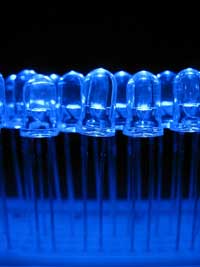
circadian rhythm
Image courtesy of Gussisaurio;
image source: Wikimedia
Commons
There are some surprisingly simple things that can be done about it though. One of the experiments at Concordia, for example, involved subtly changing the colours of the lights inside the station’s buildings. “Tests have shown that we don’t only have rods [the cells that detect light and dark] and cones [which give us colour vision] in our eyes as light receptors; there is also a third receptor that is especially sensitive to blue light,”w4 Oliver explains. “And that is not only used for vision, if at all, but also more directly linked to the sensors in the brain that control our circadian rhythm.”w5
It turns out that standard indoor lighting, even though it looks white to us, is missing a lot of the blue part of the spectrum that our brains expect during daylight hours, so our bodies don’t perceive the subtle clues that keep our body clock ticking normally. The solution? Install bluer lighting in the working areas of the station, and redder (less blue) lights in the sleeping quarters. Result? A better night’s sleep.

sunset for four months
Image courtesy of ESA –
A Kumar
Living in a small group in confined spaces also has an effect on the physical health of the station’s crew. The isolation means they get no infections from outside, leading to their immune systems weakening. But at the same time, living at such close quarters means that any infections that are present in the station are soon shared by everyone. One more way in which life at Concordia is similar to life in space.
“If you’re there, you really get the impression that you are as close to being on a different planet as you could be while staying on Earth,” says Oliver. With the last flight of the Antarctic summer having left, Alexander Kumar will be finding out just how true that is.
More about ESA

The European Space Agency (ESA)w6 is Europe’s gateway to space. Its mission is to shape the development of Europe’s space capability and ensure that investment in space continues to deliver benefits to the citizens of Europe and the world.
ESA is a member of EIROforumw7, the publisher of Science in School.
Acknowledgement
This article is based on an interview given by Dr Oliver Angerer to the editor-in-chief of Science in School, Dr Eleanor Hayes.
Web References
- w1 – Find out more about the Concordia Base and the scientific research carried out there.
- w2 – Learn more about the Mars500 project.
- w3 – Alexander Kumar’s website includes a blog and details of his work.
- w4 – For more information on how the human eye perceives colour, see the ‘Neuroscience for kids’ pages on the University of Washington website.
- Some of the ‘Neuroscience for kids’ pages are available in Belarusian, Chinese, Dutch, German, Italian, Japanese, Korean, Portuguese, Russian, Serbian, Slovene, Spanish, Telugu and Turkish.
- w5 – To learn more about the link between blue light and the circadian rhythm, see the article ‘Bring back the night – your health and wellbeing depend on it’ by neuroscientist Professor Russell Foster on the Guardian website.
- w6 – Find out more about ESA.
- w7 – EIROforum is a collaboration between eight of Europe’s largest inter-governmental scientific research organisations, which combine their resources, facilities and expertise to support European science in reaching its full potential. As part of its education and outreach activities, EIROforum publishes Science in School.
Resources
Institutions
Review
This article explains how an investigation of daily life for the crew living at the Concordia research station, on an ice plateau deep in the Antarctic, has enabled scientists to gain a deeper understanding of the implications of long space missions on astronauts’ physical and mental health.
There is a great interdisciplinary potential in this article. At lower secondary-school level it can be used as a starting point for a group discussion around the relationship between science, technology and society. Alternatively, students could list the major health challenges facing astronauts during a space trip, which are referred to in the article, and discuss the solutions presented based on research findings.
For upper secondary-school level, I believe the most appropriate subject would be biology, using the article as a starting point to reflect on homeostatic mechanisms and on how the body is influenced by external factors (such as light). Students could also discuss astronauts’ health challenges. This can be extended by investigating and reflecting on other major challenges that will have to be considered in future space missions, which are not referred to in the article. Students should suggest possible ways of investigating the impact of those factors.
Betina da Silva Lopes, Portugal





